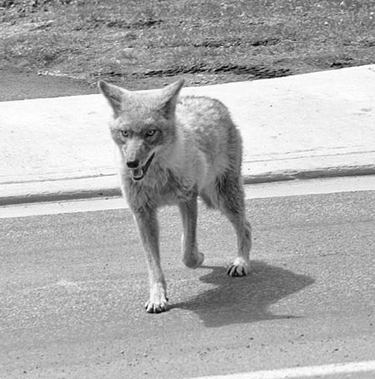Coyote Sighting
- Details
- Category: Community News
- Published on Friday, 05 June 2015 15:32
- Written by D.V. Lawrence & Joyce White
 A coyote has been spotted in the Longwood Highlands community (between Olympic and San Vicente from Rimpau to La Brea). Resident and Block Captain for the Longwood Area Neighborhood Watch, Joyce White, reports, “A HUGE Coyote, as big or perhaps BIGGER than my dog Bentley, was spotted trying to attack a small leashed dog at approximately 9:45 P.M. [Sunday May 10] The dog was terrified and could be heard screaming. The owner evidently picked up the dog and the Coyote proceeded down 12th street between Hudson and Keniston where it stood in the middle of the 4 way corner and looked back to where it just tried to get the dog! He is extremely LARGE and probably hungry and dangerous. I URGE you all, if you have a small animal and walk it in the evening hours, after dark, The coyotes are HERE and not going anywhere because they are looking for prey and water to survive. They are obviously getting it due to the size of this particular one.”
A coyote has been spotted in the Longwood Highlands community (between Olympic and San Vicente from Rimpau to La Brea). Resident and Block Captain for the Longwood Area Neighborhood Watch, Joyce White, reports, “A HUGE Coyote, as big or perhaps BIGGER than my dog Bentley, was spotted trying to attack a small leashed dog at approximately 9:45 P.M. [Sunday May 10] The dog was terrified and could be heard screaming. The owner evidently picked up the dog and the Coyote proceeded down 12th street between Hudson and Keniston where it stood in the middle of the 4 way corner and looked back to where it just tried to get the dog! He is extremely LARGE and probably hungry and dangerous. I URGE you all, if you have a small animal and walk it in the evening hours, after dark, The coyotes are HERE and not going anywhere because they are looking for prey and water to survive. They are obviously getting it due to the size of this particular one.”Coyotes love our neighborhoods because of the bounty of food available to them- fruit trees, pet food left out in the yard and of course the small cats and dogs. Their presence is known not only by sightings but by the sudden appearance of lost dog and cat posters. As they settle into a community coyotes begin to feel comfortable around people and will appear unafraid. Although attacks on humans are extremely rare, they have been known to bite the hand that either feeds them, attempts to take their prey away or corners them. The Humane Society suggests that if you have a coyote in your neighborhood you engage in something called “Hazing” These techniques are designed to let the coyote know their presence is not tolerated and to instill fear in the coyote towards humans.
From the Humane Society - Methods of hazing
Using a variety of different hazing tools is critical so that coyotes don’t get used to redundant or single stimulus devices, sounds, and actions.
- Yelling and waving your arms while approaching the coyote.
- Noisemakers: Voice, whistles, air horns, bells, “shaker” cans full of marbles or pennies, pots, lid or pie pans banged together
- Projectiles: sticks, small rocks, cans, tennis balls or rubber balls thrown Near not AT.
- Other: hoses, water guns with vinegar water, spray bottles with vinegar water, pepper spray or bear repellent
“Go away coyote!”
The simplest method of hazing a coyote involves being loud and large:
Stand tall, wave your arms, and yell at the coyote, approaching him if necessary, until he runs away.
If a coyote has not been hazed before, he may not immediately run away when you yell at him. If this happens, you may need to walk towards the coyote and increase the intensity of your hazing.
The coyote may run away, but then stop after a distance and look at you. It is important to continue to go after the coyote until he completely leaves the area. You may need to use different tactics, such as noisemakers, stomping your feet, or spraying the coyote with a hose, to get him to leave.
Dog-walking tools
There are several tools that you can carry with you while walking your dog that can be used to repel coyotes. These include:
- Homemade noisemakers
- Whistle or small air horn (you can purchase small air horn “necklaces”)
- Squirt guns
- Pepper spray
- Sticks or other objects to throw towards (but not at) the coyote
In your yard
Remember, keeping pets and pet food inside is the best way to keep coyotes out of your yard. If you do encounter coyotes, all of the above methods can be used in your yard at home. First, try the “Go away coyote!” method. Here are some additional methods you can also use:
- Squirt the coyote with your garden hose
- Spray the coyote with vinegar water
- Bang pots and pans together
Important things to remember
- Never run away from a coyote!
- The coyote may not leave at first, but if you approach him closer and/or increase the intensity of your hazing, he will run away.
- If the coyote runs away a short distance and then stops and looks at you, continue hazing until he leaves the area entirely.
- After you have successfully hazed a coyote, he or she may return. Continue to haze the coyote as you did before; it usually takes only one or two times to haze a coyote away for good.
